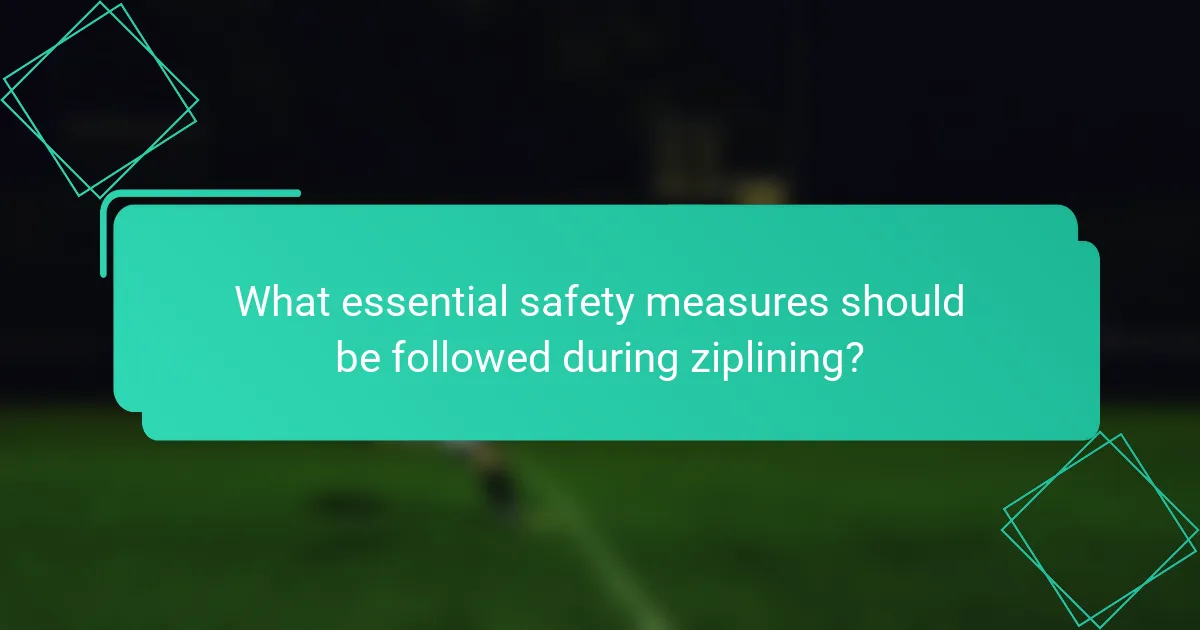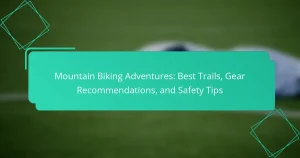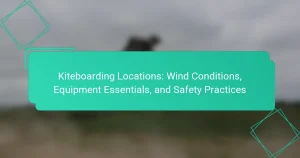Ziplining offers an exhilarating way to experience nature, combining stunning views with an adrenaline rush. Discover top locations like Costa Rica and the Swiss Alps, learn essential safety measures, and explore the gear needed for a secure adventure. Understand the importance of proper equipment checks and following guide instructions to ensure a safe and enjoyable experience.

What makes ziplining a popular adventure activity?
Ziplining is popular due to the thrilling experience of soaring through nature, offering unique views and adrenaline rushes. Top locations like Costa Rica and the Swiss Alps provide stunning backdrops. Safety measures include harness checks and trained guides, ensuring a secure adventure. Essential gear consists of helmets and gloves, enhancing safety and comfort during the ride.
How does ziplining enhance outdoor experiences?
Ziplining significantly enhances outdoor experiences by providing adrenaline-pumping thrills and unique scenic views. It allows participants to connect with nature from an elevated perspective, often in breathtaking locations. Safety measures, such as harness checks and trained guides, ensure a secure adventure. Essential gear, including helmets and gloves, enhances comfort and protection while maximizing enjoyment.
What are the psychological benefits of ziplining?
Ziplining offers significant psychological benefits, including reduced stress and enhanced mood. The thrill of soaring through the air promotes adrenaline release, which can elevate happiness levels. Engaging in this adventurous activity fosters a sense of accomplishment and boosts self-confidence. Additionally, being in nature during a ziplining experience can improve mental well-being and encourage mindfulness.

Which are the top ziplining locations in North America?
The top ziplining locations in North America include Whistler, British Columbia; Puerto Rico; and the Smoky Mountains in Tennessee. These destinations offer thrilling experiences with stunning views and varying levels of difficulty. Whistler features the longest zipline in North America, reaching speeds up to 100 mph. Puerto Rico’s lines traverse lush rainforests, showcasing diverse wildlife. The Smoky Mountains provide a unique experience with panoramic vistas of the national park. Safety measures at these locations typically include harness checks, trained guides, and strict adherence to equipment standards. Essential gear includes helmets, gloves, and comfortable clothing for optimal safety and enjoyment.
What unique features do Canadian ziplining experiences offer?
Canadian ziplining experiences offer breathtaking views, diverse terrains, and unique wildlife encounters. Many locations feature ziplines that traverse stunning landscapes, such as mountains and forests. Safety measures are stringent, including trained guides and high-quality gear. Unique attributes include ziplining over waterfalls or through canyons, enhancing the thrill. Some experiences may also incorporate cultural elements, showcasing local heritage and traditions, creating a memorable adventure.
How do ziplining experiences in the UK differ from those in the US?
Ziplining experiences in the UK often emphasize scenic landscapes and historical sites, while those in the US focus on adventure and diverse terrains. UK ziplining locations frequently incorporate natural beauty, such as forests and castles, enhancing the cultural experience. In contrast, US ziplining may feature longer lines and higher altitudes, catering to thrill-seekers. Safety measures in both regions are stringent, but US operators may have more varied regulations due to state differences. Essential gear is similar, including harnesses and helmets, but US experiences often offer advanced options like gloves for better grip.

What essential safety measures should be followed during ziplining?
To ensure safety during ziplining, follow essential measures like wearing a harness, ensuring proper equipment checks, and adhering to guidelines. Always listen to your guide and maintain a safe distance from others.
1. Wear a properly fitted harness.
2. Check equipment before use.
3. Follow the guide’s instructions.
4. Maintain a safe distance from other zippers.
5. Avoid loose clothing and accessories.
6. Stay aware of your surroundings.
How can participants prepare for a ziplining adventure?
Participants can prepare for a ziplining adventure by focusing on physical fitness, wearing appropriate clothing, and reviewing safety guidelines. Prioritize cardiovascular strength and flexibility to enhance endurance during the experience. Wear comfortable, weather-appropriate clothing and closed-toe shoes. Familiarize yourself with safety measures, including harness usage and emergency protocols. Having a positive mindset and being open to adventure further enriches the ziplining experience.
What equipment is crucial for ziplining safety?
Crucial equipment for ziplining safety includes harnesses, helmets, gloves, and safety lanyards. Each item plays a vital role in ensuring participant protection during the experience.
Harnesses securely attach riders to the zipline, while helmets protect against head injuries. Gloves enhance grip and protect hands from friction. Safety lanyards connect riders to the zipline and act as a backup safety measure. Proper maintenance and regular inspection of this gear are essential for optimal safety.

What gear essentials are needed for ziplining?
Essential gear for ziplining includes a harness, helmet, gloves, and appropriate footwear. A harness secures you to the zipline, while a helmet protects your head. Gloves provide grip and protect your hands during the ride. Sturdy footwear ensures stability and safety on the platform and ground.
Which types of harnesses are best for ziplining?
The best types of harnesses for ziplining are full-body harnesses and seat harnesses. Full-body harnesses distribute weight evenly and provide maximum safety, suitable for various body types. Seat harnesses are lighter and easier to put on, ideal for shorter ziplining experiences.
What role do helmets play in ziplining safety?
Helmets play a crucial role in ziplining safety by protecting the head from potential impacts. They reduce the risk of head injuries during falls or collisions. High-quality helmets are designed to absorb shock and provide a snug fit, enhancing overall safety. Regular inspections ensure helmets remain in optimal condition, which is vital for a safe ziplining experience.
How does weather influence ziplining gear choices?
Weather significantly influences ziplining gear choices, affecting safety and comfort. Rainy conditions require waterproof gear, while sunny weather necessitates UV protection. Windy conditions may call for more secure harnesses and helmets. Temperature variations also dictate clothing layers and insulation. Choosing appropriate gear ensures an enjoyable and safe ziplining experience.

What are the common challenges faced during ziplining?
Ziplining experiences often face challenges like equipment failure, weather conditions, and safety concerns. These factors can impact the enjoyment and safety of participants. Equipment failure may lead to delays or cancellations, while adverse weather can pose risks. Additionally, safety concerns may arise from inadequate training or supervision. Proper planning and adherence to safety measures can help mitigate these challenges.
How can ziplining risks be minimized?
To minimize ziplining risks, adhere to safety protocols, use high-quality gear, and undergo proper training. Ensure the zipline location follows industry standards and conducts regular equipment inspections.
1. Choose reputable zipline operators with certified staff.
2. Wear appropriate safety gear, including helmets and harnesses.
3. Follow all safety briefings and instructions from guides.
4. Avoid ziplining in adverse weather conditions.
5. Regularly check equipment for wear and tear before use.
What should you do in case of an emergency while ziplining?
In case of an emergency while ziplining, remain calm and follow safety protocols. First, alert the zipline staff or guides immediately. They are trained to handle emergencies and will provide assistance. If you are suspended, stay in your harness until help arrives to avoid falls. Always follow the specific safety instructions provided by the zipline operator prior to your experience.

What are the best practices for a successful ziplining experience?
To ensure a successful ziplining experience, prioritize safety, choose reputable locations, and use appropriate gear. First, select ziplining sites known for their safety protocols and experienced staff. Always wear a helmet and harness properly to prevent accidents. Check weather conditions before your adventure, as adverse weather can pose risks. Lastly, follow all instructions given by guides to enhance both safety and enjoyment.
How can participants maximize their enjoyment while ziplining?
Participants can maximize their enjoyment while ziplining by preparing adequately and embracing the experience. Choose a scenic location known for diverse landscapes, which enhances the thrill. Prioritize safety by wearing appropriate gear, including harnesses and helmets, and follow all instructions from guides. Embrace the adventure by engaging with your surroundings, taking in the views, and enjoying the adrenaline rush. Lastly, consider going with friends or family to share the experience, making it more memorable and enjoyable.
What common mistakes should be avoided during ziplining?
To ensure a safe and enjoyable ziplining experience, avoid these common mistakes.
1. Neglecting safety gear: Always wear a helmet and harness properly to prevent injuries.
2. Ignoring weight limits: Check the zipline’s weight restrictions to ensure safety.
3. Failing to listen to guides: Follow instructions from trained staff to avoid accidents.
4. Rushing through the experience: Take your time to enjoy the ride and adhere to safety protocols.
5. Not checking equipment: Inspect harnesses and cables before use to ensure they are in good condition.
6. Overlooking weather conditions: Avoid ziplining in adverse weather, such as high winds or rain, which can increase risks.


